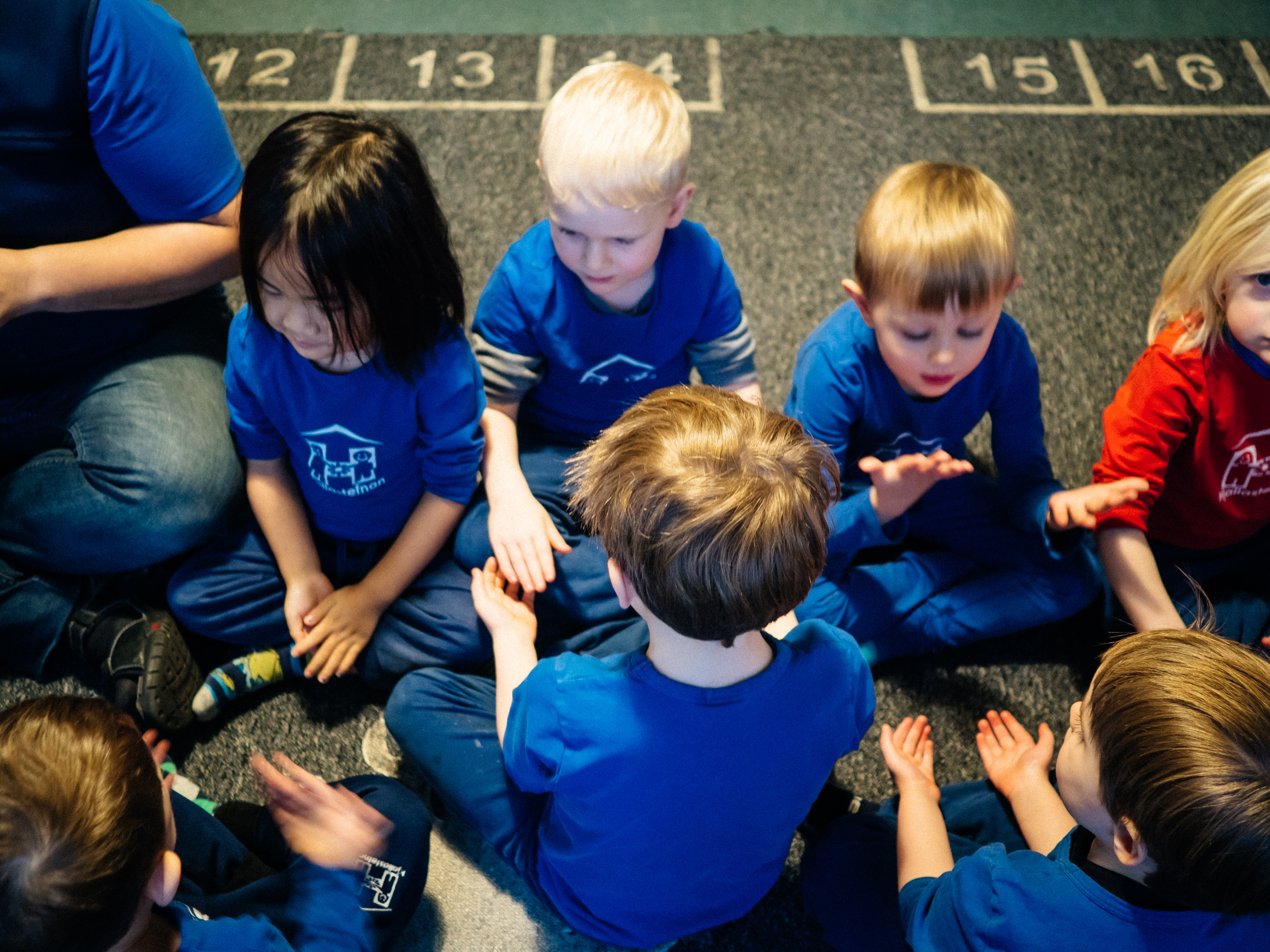About The Hjalli Model
HEALTHY AND POWERFUL GENDER SELF IMAGE
“Children at Hjalli model schools receive training in all human qualities as we believe that all children should have all the possibilities in the world regardless of their gender.”
”
THE THREE PILLARS
UPON WHICH THE HJALLI PEDAGOGY FOUNDATION RESTS
Equality in kindness and joy
Our aim is equality for all people. That is what we desire. That is why our children work in small single-sex groups for the biggest part of their school day; to make sure that girls and boys get even attention and equal opportunities in the classroom. School uniforms ensure that all the children are part of the same team, which gives them a sense of belonging.
Creativity in positivity and resilience
Our world needs new ideas and new approaches. To encourage imaginative and innovative thinking, we use open-ended materials such as homemade Play- Doh and plasticine, wooden blocks, paper and crafts materials, water and sand and blankets and pillows. Such materials enhance the children‘s creativity that prompts original problem solving, collaboration and resilience. Our teachers emphasise original and unusual projects and new experiences to heighten the development of the brain at the child‘s significant period of development.
Democracy in respect and freedom
Our ethos and school society revolve around the human rights of children. That is why the children cultivate respectful communication through positive discipline, so all children enjoy equality. To establish this, there are daily choose-meetings for playtime and regular democracy conferences. All children must speak in front of a group and express their wishes, opinions and ideas positively.
Testimonials
“I hold Margrét Pála in high esteem and she genuinely gets my sincerest recommendation. I have followed her work for a long time and have admired her relentless determination to materialize her ideals. Margrét Pála has received well deserved attention in Iceland for developing her unique theory and teaching method for nurseries, devoting her time and efforts to the youngest generation. Due to Margrét Pála‘s sympathy for the wellbeing of children, thousands of Icelandic children have benefitted from her pedagogy that gently directs them towards their true personal essence and growth.”
-Jóhanna Sigurðardóttir, Former Prime Minister of Iceland
“Margrét Pála Ólafsdóttir has for decades been a pioneer in the fields of education and gender equality in Iceland. I have gotten to know her work, particularly when I was active in Icelandic politics as a Member of Parliament and a Cabinet Member. Her ideas and the way they have been implemented through the Hjalli model have proven to be highly successful for young boys and girls. This I have personally witnessed through some of my own grandchildren.”
- Geir H. Haarde, Former Prime Minister of Iceland
“The Hjalli model has been a pioneering approach with regards to gender in the Icelandic Education system. Tackling harmful gender stereotyping from a very early age is of great value to society as a whole. I also applaud how democratic values and participation are an integral part of in Hjalli's pedagogy.”
- Stefán Haukur Jóhannesson, Ambassador of Iceland to the United Kingdom
Hjalli Model Curriculum
“We make sure boys and girls receive equal attention.”
The gender-based curriculum is a manifestation of the Hjalli model‘s vision of gender equality, and it‘s effort to meet the different needs of individuals. Due to inhibiting gender roles and gender moulding which the society determines on the basis of sex, the Hjalli model trains all children, regardless of their gender, in all human qualities through courses of the gender-based curriculum.
Social Qualities
Course 1: Respect
Key concepts are order, behaviour, manners and presentation.
Course 3: Communication
Key concepts are acceptance, open-mindedness, helpfulness and solidarity.
Course 5: Friendship
Key concepts are companionship, compassion, warmth and kindness.
Individual Qualities
Course 2: Independence
Key concepts are empowerment, confidence, self-reliance and expression.
Course 4: Positivity
Key concepts are assertiveness, candour, optimism and joy.
Course 6: Courage
Key concepts are bravery, strength, action and initiative.
Hjalli Model Research
Iceland ranks first for gender equality worldwide
The Global Gender Gap Index
The past nine years Iceland has ranked first for gender equality worldwide regarding women’s economic participation, educational attainment, health and political empowerment according to The Global Gender Gap Report published by The World Economic Forum. This global report ranks all countries on a 0-to-1 scale, and Iceland is “the frontrunner” for the tenth year in a row. Ranking at the top is a confirmation of Iceland’s successes achieved in recent decades and should inspire the world to continue to work towards complete equality of status, influence and power of men and women.
Positive research outcomes
With nearly 3 decades of operation the Hjalli Model has grown and strengthen its environment to create the best possible conditions for children and their families based on the ideology to accept each child as they are, and respect and acknowledge individual needs while maintaining the highest of standards to foster success for everyone. Emphasis on satisfaction surveys within the schools are given to children, parents and teachers, this has been an instrumental tool for internal evaluation and to foster positive development of the Hjalli Model. In our long history we’ve welcomed questions and research regarding the capabilities and success of our children once they have left our nurseries and schools. In all these years several Icelandic studies have been conducted on the Hjalli Model, far more than on other nurseries and primary schools in Iceland. To some extent, they have indicated similar results with students from external control groups, but in many areas there have been significant differences, and always to the benefit of the children from Hjalli Model nurseries and schools as the following data will show.
Examples of Gender Research and Articles
Patterns of Gender Development
“Taken together, these studies suggest that most children develop the ability to label gender groups and to use gender labels in their speech between 18 and 24 months ... developing this ability has consequences: Knowing basic gender information was related to increased play with strongly stereotyped toys. These findings are consistent with research suggesting that children develop awareness of their own “self ” at roughly 18 months and then begin to actively engage in information seeking about what things mean and how they should behave ...”
The Beginning Of ‘Two Cultures’: By Preschool, Boys And Girls Are Already Segregated
“When preschool teachers take a break to get snacks ready or prepare for the next activity, they usually let students engage in play for an hour or half hour-long chunk of time. In many preschools, children may simply head toward several bins full of toys or a kitchen playset. ... Whether boys choose to play with blocks or girls choose to play with baby dolls may seem inconsequential. But the gendered nature of kids’ play activities may actually have serious consequences — depriving children from developing certain skills and preventing them from learning how to socialize across genders.
Young children learn gender norms quickly and tend to bring them into their school environment. Preschool play activities can end up reinforcing that. Unfortunately, preschool teachers may have no idea that gendered play is a problem and may not be aware of their own gender assumptions. A 2015 case study shows early childhood educators’ perceptions of gender end up affecting children’s play.
Parents may think preschoolers are way too young to have already absorbed all of these messages about gender ... evidence that by the time kids enter preschool at age three or four, they’ve already been exposed to these messages through cultural influences, such as the highly gender-segregated toy shelves in department stores. Early childhood programs often do little if anything to combat these cultural influences.”
The Role of Sex of Peers and Gender‐Typed Activities in Young Children's Peer Affiliative Networks: A Longitudinal Analysis of Selection and Influence
Children's tendency to interact with members of their own sex (i.e., sex homophily) is a ubiquitous pattern and leads them to spend much of their social time in sex-segregated groups. Sex segregation occurs in different cultures, ages, and settings ... The broader picture that emerges from our findings is that gender has a powerful effect on children's sex segregation through multiple pathways. First, segregation is promoted directly through children's tendencies to select same-sex interactional partners . Tendencies for a child to be drawn to peers engaging in similar levels of gender-typed activities also promoted sex segregation since those peers likely were of the same-sex as the child. Two reciprocal feedback loops contribute to segregation in more complex ways. The first feedback loop involves children becoming socialized by peers into gender-typed activities, which then serve as a basis for subsequent friendship selection based on similar levels of gender-typed activities. The second feedback loop involves structural network processes that can amplify sex segregation. As a consequence of these complex processes, small preferences for sex homophily or small preferences for sex-typed activities can become magnified to produce high levels of sex segregation.
Tracking gender in kindergarten
“Norwegian society emphasises that ideally gender should not limit educational or career choices ... kindergartens and schools are required by law to focus on equality and to avoid gender stereotyping. According to research, perceptions of gender stereotyping in kindergartens and schools contribute to limiting children’s freedom to make their own educational choices according to their interests and strengths. ....There is little awareness of perceptions of gender stereotyping in kindergartens and schools. Work to change stereotypical attitudes needs to start in kindergarten, but the challenge here is that kindergarten and school staff can lack awareness of their own attitudes. ... Thus, the choices that girls and boys make are not as free and personalised as the individual or society would like to think.”
Appearance: The data material shows that the students perceived that kindergarten staff accentuate the children’s characteristics by highlighting girls’ and boys’ appearance, size and physical skills. The analysis shows that boys receive comments on size and strength, and motor skills are also emphasised, while girls are told that they are sweet and cute. ... Clothes are subject to similar attention. Girls in dresses, lace and bright colours are nice and sweet, while boys in trousers and jumpers are rough and tough.
Care: In areas such as eating, washing, dressing themselves and tidying up, the analysis of the students’ observations shows that girls to a greater degree than boys are encouraged to show care towards others. In many cases, the girls are the little helpers in kindergarten:
Attention: The students’ observations show that kindergarten staff give the boys more attention than the girls. Even though both genders may be active participants in activities; nevertheless, the students felt that the boys captured the attention of the staff to a greater extent. Attention is given through words, looks, body language and other non-verbal communication.”
Kindergarten boys less interested in language activities, study indicates
A Norwegian study of kindergarten children reveals that girls are more interested in language activities than boys. As a result boys may receive less linguistic stimulation and become less prepared for school than girls. … The children were between 30 and 33 months old at the time of the study, which showed that the girls were more interested and willing participants in language activities offered by the kindergarten such as reading and singing.
Gender Differences: Preschool
Sugar and Spice and Everything nice vs. Frogs and Snails and Puppy Dog Tails? The gender differences aren't exactly that clear-cut. But by preschool, children identify themselves as male or female, and gender differences in their behavior may already be apparent. Four-year-olds tend to judge others’ genders based on superficial characteristics – assuming, for example, that anyone with long hair must be female, and that perhaps that person’s gender might change with a haircut. Because they don’t understand that gender is constant, they tend to identify with stereotypical male and female activities, says Sharon Carver, Ph.D, Director of the Children’s School and Professor of Psychology at Carnegie Mellon University.
Gender differences in the classroom
“Gender roles are the patterns of behaviors, attitudes, and expectations associated with a particular sex—with being either male or female. For clarity, psychologists sometimes distinguish gender differences, which are related to social roles, from sex differences, which are related only to physiology and anatomy. ... Although there are many exceptions, boys and girls do differ on average in ways that parallel conventional gender stereotypes and that affect how the sexes behave at school and in class. The differences have to do with physical behaviors, styles of social interaction, academic motivations, behaviors, and choices. They have a variety of sources—primarily parents, peers, and the media. Teachers are certainly not the primary cause of gender role differences, but sometimes teachers influence them by their responses to and choices made on behalf of students.”
The Role of Schools in the Early Socialization of Gender Differences
“The question of how gender differences arise is a central topic in psychology. Experts agree that nature (i.e., biology) and nurture (i.e., environment) act together in reciprocally causal, interactive ways to produce gender differences. The experiences afforded to girls and boys within schools are known to affect gender differentiation both directly, by providing differential skill practice and reinforcement,2 and indirectly, by providing input that leads children to actively socialize themselves along gender-differentiated pathways. ... For nearly all psychological traits on which young boys and girls differ (e.g., reading ability, play preferences), the distribution of the two groups is overlapping. Schools can magnify or diminish gender differences by providing environments that promote within-gender similarity and between-gender differences, or the inverse (within-gender variability and between group similarity).”
Conclusions: Schools are important contexts for the socialization of young children’s gender attitudes and behaviour. Teachers and classmates shape children’s gender attitudes and, in turn, gender differences in cognition and behaviour. Unfortunately, teachers receive relatively little training in recognizing and combating gender stereotypes and prejudices—their own and others—and, as a consequence, teachers often model, expect, reinforce, and lay the foundation for gender differentiation among their pupils. Thus, most schools create and maintain—rather than counteract—traditional gender stereotypes, biases, and differences. However, educators who adopt a commitment to gender egalitarianism and thus promote cross-gender interaction, expose pupils to counter-stereotypic models, and discuss and teach challenges to gender stereotyping and harassment optimize their pupils’ developmental outcomes.
Boys and Girls on the Playground: Sex Differences in Social Development Are Not Stable across Early Childhood
“Sex differences are not stable throughout social development, but they rather reflect a developmental gap between girls and boys. ... Our study highlights that although all children progress towards more socially oriented and skilful forms of play during early childhood, girls develop social and structured forms of play at younger ages than boys. Preschool boys also display more solitary play than preschool girls. However, boys catch up at the following developmental stages.”









